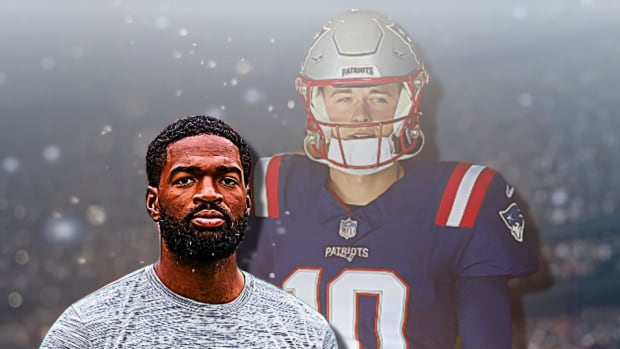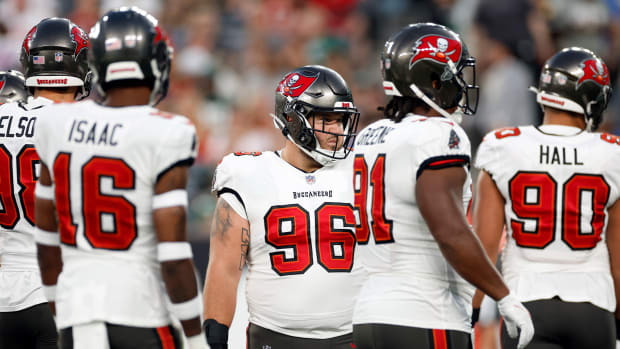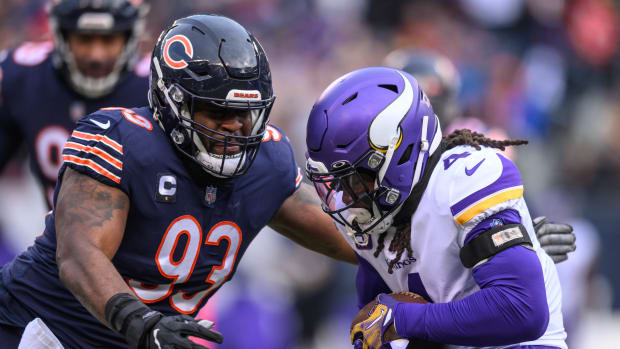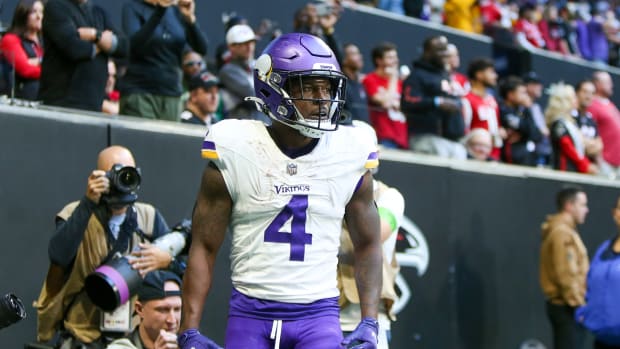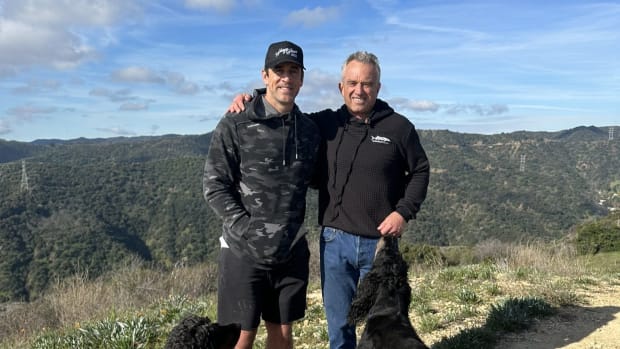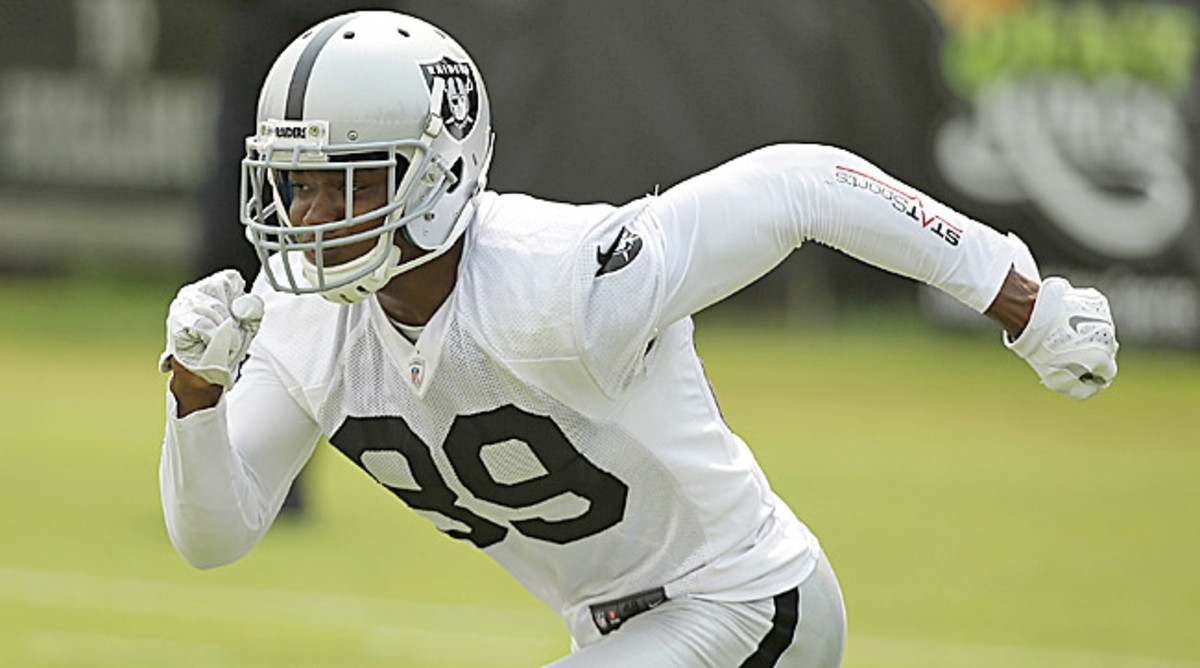
The Raiders Are Finally In Good Hands
Around late summer for the past dozen years, Raiders fans have thought a new day awaits their team. And, aside from back-to-back .500 seasons in 2010 and ’11, Oakland has answered that optimism with a season of 11 or more losses. A staggering eight different head coaches have overseen this stretch of futility.
Identifying the root of the problem is a lot like trying to identify the angriest person in a mob. There are myriad off-field items to point to, many of which, sadly, still tie to Al Davis’s final years. But if we’re to confine our search to strictly the field, the Raiders’ most consistent problem has been their wide receivers’ inability to win in one-on-one situations, particularly against man coverage.
In simplest terms, there’s been a paucity of talent at the position. But it’s not like the Raiders haven’t tried to address it. After Tim Brown and Jerry Rice left, they correctly made up-and-comer Jerry Porter the featured guy. An intriguing No. 3 receiver, Porter never quite flourished as a No. 1. In 2005, the Raiders acquired a known No. 1, Randy Moss. Though still in his prime, he averaged a middling 51 catches and 779 yards in his two years here. In ’08 they paid big money for ex-Packer Javon Walker. He played all of nine games in the Bay. In ’09, the Raiders used the seventh overall pick in the draft on who they hoped was a young Moss, Darrius Heyward-Bey. The Maryland speedster reminded everyone that catching the ball is sort of an important prerequisite for being a professional wide receiver. The next relatively notable move came last year, when James Jones was signed for $11.3 over three years. It took GM Reggie McKenzie all of one season to see what his and Jones’s former club, the Packers, had already known: the then-30-year-old was best suited to be a cog in a passing attack, not a featured weapon. McKenzie released Jones this past offseason.
With more and more NFL defenses playing matchup-based coverages, it’s tough to function offensively if your receivers can’t win one-on-one. Spreading the field becomes perilous; third downs are a nightmare; turnovers are more likely. True, there are ways to mask such receiving deficiencies. Bunch and stack alignments, pre-snap motion and unbalanced or condensed formations can all force man-to-man defenders to at least give a cushion. But unless your quarterback is Tom Brady, you’re not going to sustain significant success with this sort of makeshift approach.
That’s why, after releasing Jones, McKenzie doubled down on the wide receiver issue. Maybe this time Raiders fans really can safely believe it’s a new day. Sure, this past offseason brought yet another coaching change; Jack Del Rio and a staff comprised largely of veteran retreads was brought in. In coaching, a bunch of veteran retreads isn’t the worst thing. In some ways, it might even be a good thing. But it doesn’t exactly galvanize a fan base. Neither does continued talks about the franchise relocating to Los Angeles, which have gained steam. But none of this is new for the Silver and Black.
What is new is having a receiving corps that might actually scare defenses. On draft night, McKenzie used the fourth overall pick on Amari Cooper. You never know about a guy until he faces actual NFL competition, but let’s assume the Alabama product is every bit as dynamic as expected. First-round wideouts have mostly panned out in recent years. (For every Justin Blackmon there’s an A.J. Green and a Julio Jones). Cooper is said to be one of the most polished all-around receivers to ever enter the league. Prior to that selection, McKenzie signed free agent Michael Crabtree—the wideout Al Davis once passed on in order to draft Heyward-Bey. Crabtree is not a burner; he won’t stress coverages downfield. But with fluid hips, deft feet and magnetic hands, he has a unique knack for creating separation and adjusting to balls at the underneath and intermediate levels. He can consistently beat man-to-man coverage.

Cooper (left) and Crabtree are just what the Raiders needed in the receiving corps. (Eric Risberg/AP)
With a starting receiver duo that’s not just acceptable but possibly exceptional, new offensive coordinator Bill Musgrave can expand his approach in ways predecessor Greg Olson never could. The dearth of receiving talent often constricted Olson to elementary play designs out of base personnel packages (i.e. two receivers teamed with two backs or two tight ends). From here, Olson was limited. Musgrave won’t be. If he wants to play out of base packages, in addition to the wideouts, he has a unique pass-catching fullback in Marcel Reece and a little known third-year tight end, Mychal Rivera, who can flex out and win athletic battles against safeties around the seams. There’s also third-round rookie tight end Clive Walford, who should eventually play ahead of free agent pickup Lee Smith (a blocking-oriented ex-Bill whom McKenzie signed for well above sticker price at $9 million over three years).
Musgrave also has the option to go small and spread the field with three or four receivers. The guys Oakland had been forcing into the starting lineup—namely Andre Holmes and Rod Streater—are now backups and will finally be on the right side of a mismatch. Holmes, a long-striding, acrobatic outside threat, showed newfound diversity as a route runner last year, racking up a team-leading 693 yards. Streater missed most of the season with a fractured foot; when healthy, he’s a fundamentally sound inside weapon who should flourish if allowed to focus solely on playing the slot.
Oh, and it bears mentioning, there’s someone to throw the ball to this revamped receiving corps. The Raiders have found their eventual franchise quarterback in Derek Carr. At this point, Carr can, stylistically, be described as a poor man’s Aaron Rodgers. Expect his up-and-down decision-making to stabilize in Year Two. Musgrave does a good job of calling plays that make life easier on a QB.
What also makes life easier on a QB is a clean pocket—something Carr had surprisingly often last season. Left tackle Donald Penn is coming off what was by far the best year of his career (2010 Pro Bowl season included). Left guard Gabe Jackson is a developing mauler who can hold ground against bull rushers. The line’s right side is less reliable but equally gifted—or at least it can be if third-year man Menelik Watson beats out Khalif Barnes and J’Marcus Webb to start alongside Austin Howard. Watson has mostly played right tackle in the NFL; having shorter arms, he’d be better at guard. That would allow Howard to move back to his natural right tackle position. In the middle of this line is free agent pickup Rodney Hudson, one of the five best centers in football.
With an intriguing young quarterback, solid line and a viable receiving group (praise the Lord!), the long-standing question marks that have pocked Oakland’s pass attacking will soon be replaced by exclamation points. Go ahead, Raiders fans. Allow yourself to proclaim: It’s a new day in Oakland.

The passing attack is on its way. Can Latavius Murray carry the running game to bigger and better things? (Thearon W. Henderson/Getty Images)
Raiders Nickel Package
1. Improvements in the passing game are nice, but investments there won’t provide a full return if the Raiders’ 32nd ranked rushing attack doesn’t improve. Last season Oakland often didn’t even bother with the run, attempting a league-low 21 rushes per game. That was due to having no confidence in the front five. Despite averaging a massive 320 pounds, the Raiders O-line regularly failed to get any push on the ground last season. Having Hudson at center should help, but other men simply must play with more initial burst and leverage. If running back Latavius Murray stays healthy, he’ll be The Guy. Murray can accelerate, but mostly just going north and south. He doesn’t have a lot of lateral pop. This sort of downhill style is fine, as long as there’s sound blocking.
2. Besides the capacity—and willingness—to make all the throws, the most encouraging aspect to Carr is the responsibility he assumed in the pre-snap phase as a rookie. Carr understands football, which is why he was able to make headway in correcting many of his weaknesses over the course of his rookie season. His most notable improvement was his poise in a muddied pocket.
3. Khalil Mack is coming off the most dominant four-sack season of any pass rusher in NFL history. It would be a shock if he doesn’t post double digit quarterback takedowns in 2015. Mack might already have the league’s finest combination of initial burst and short-area lateral redirect prowess. He amplifies this with great technique and an innate understanding of angles.
4. The $64,000 question: What type of system will Mack play in? We know he’ll rush from the edge in nickel and dime. But how will he line up in Jack Del Rio’s base 4-3? In Denver, Del Rio coached a similar type of talent, Von Miller, who was used as a standup strongside backer in base packages. With so much veteran talent at all three levels of that Broncos defense, there was added flexibility for how to employ Miller in sub-packages. Del Rio, a longtime straight zone acolyte, grew more comfortable with man-based concepts, propagating blitzes and disguise. In Oakland, he has more young defensive talent than people realize. Linebacker Sio Moore is a budding star who should thrive in a run-and-chase scheme, and corners D.J. Hayden and Travis Carrie were terrific down the stretch in 2014. (Oversized fourth-rounder Keith McGill is intriguing, as well.) That said, these strong spots are offset by a few positions of question: Nate Allen at safety? Curtis Lofton at middle linebacker? Stacy McGee and Justin Ellis at defensive tackle with Dan Williams? (The questions seem to run right through the middle of this defense.) It wouldn’t be surprising if Del Rio simplified and put his men in a straightforward Cover-2/Cover-3 zone.
5. The other issue Del Rio will bump into on defense is a lack of depth. That has contributed to this club wearing down in past years, and it will probably limit the diversity of Del Rio’s sub-package designs.
































